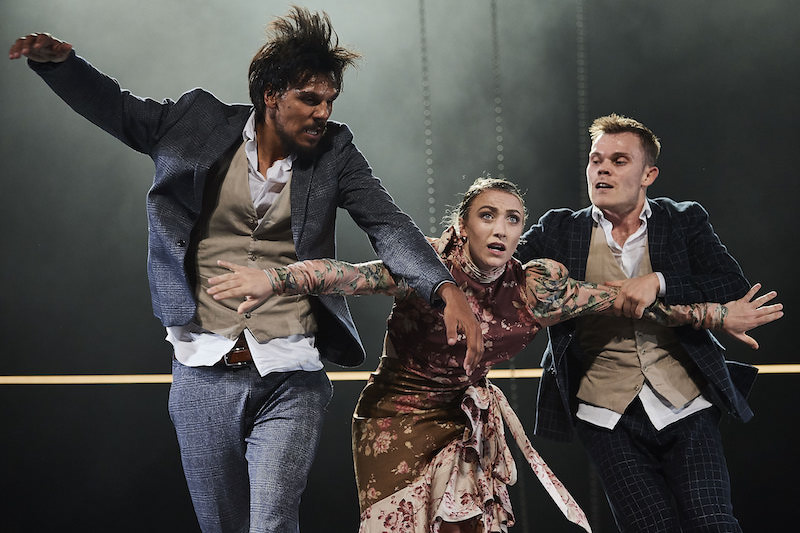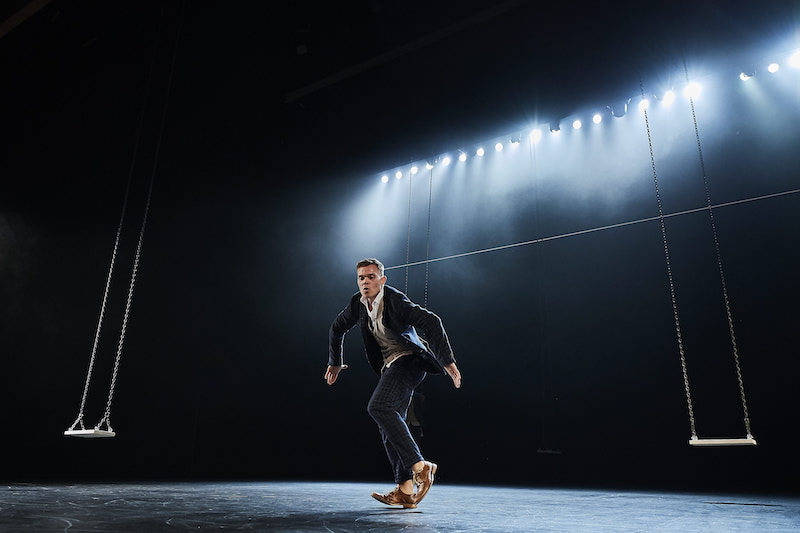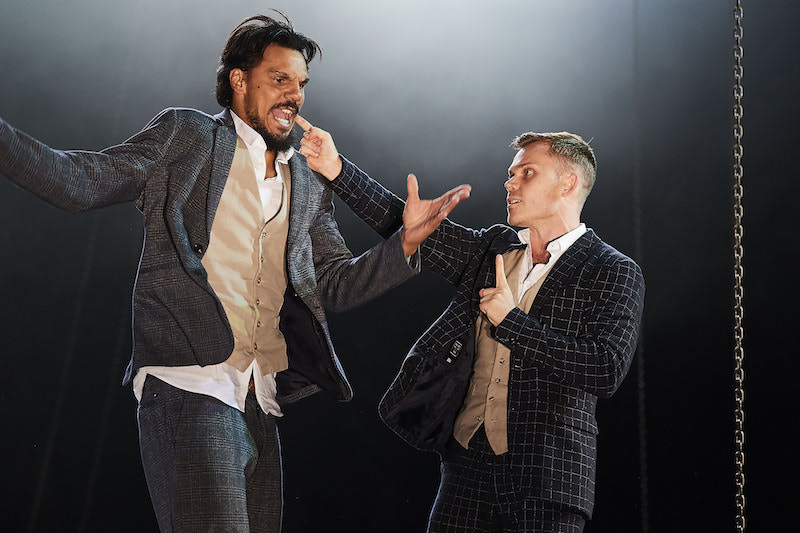The Line is a three-hander from Co3 choreographed by artistic director Raewyn Hill in association with Mark Howett of Ochre Dance and The Farm. Although Hill’s elegant lines and slightly jagged swirls of the limbs are clearly present (especially in the multiple short solos), it is Howett’s approach to structure and physical conflict that distinguishes the overall performance.
 Ian Wilkes, Katherine Gurr and Andrew Searle. Photograph © Daniel Carson
Ian Wilkes, Katherine Gurr and Andrew Searle. Photograph © Daniel Carson
The piece takes its title from the infamous colour bar enforced in several West Australian settlements, which made it illegal for Indigenes and indeed most people of colour to be within city limits after dark. This topic has been dealt with choreographically by Broome’s Marrugeku (Burning Daylight), in film (The Coolbaroo Club) and theatre (Yirra Yaakin’s Waltzing the Wilarra). Co3’s The Line is perhaps the most abstract of these treatments.
Hill and Howett take their inspiration from accounts of a rare locale in Perth where these rules where routinely flaunted, namely the working class carnival grounds variously known as “Ugly Town” (after the charitable men’s association which administered it) or “White City” (after its main building, which was intended to evoke another of the same name from the 1893 Chicago World Fair).
The Line opens with the cast hanging from three of approximately five swings at the end of long chains which disappear upwards in the fly gallery. Near the conclusion of the piece, a lone dancer (Ian Wilkes) swings towards the audience in wide, powerful arcs, reaching high before falling back each time, a possible transcendence of racism and social pain which never quite works because the soaring body must always return to earth.
In addition to the set, the music also places us in the realm of this slightly run-down early 20th century entertainment complex. The score from Eden Mulholland (guitar, mandolin, piano, voice) and James Crabb (accordion and electronics) recalls Tom Waits’ deliberately punk-ish adoption of European folk and traditional forms which eventually explode into something darker, more electric and distorted.
 Andrew Searle. Photograph © Daniel Carson
Andrew Searle. Photograph © Daniel Carson
The Line features a well turned out, white lad about town (Andrew Searle), an equally dapper black man (Wilkes), and a white woman in a flowing, frilled dress, the colours of which are subdued, yet the patterning is intense (Katherine Gurr). These costumes thereby identify our characters as 1920s working class folk out in their finest.
The relationship between the trio is unstable, and they do not necessarily play the same characters throughout. These are rather types, standing in for a moment of historical possibility, a realm where shared games and dances often seemed more important than social constraints, but where these constraints never entirely left. The performance thus shifts from slapstick fun (a repeated, loose-limbed man-versus-authority-figure sketch) to gestures which are tense, riven, and finally all but exhausted.
Searle periodically calls Wilkes out for being behind the line, shouting out: “You”! But he is not a policeman, and at other times he interacts positively with Wilkes. Exchanges alternate from friendly, yet still pained physically powerful exchanges, slapstick pursuits, and then into Howett’s characteristically extended, grabby, awkward piling of bodies into, and against, each other. The men push and clamber at one another, Gurr’s face is smothered by a wayward palm, unsteady, unstable lifts and climbs build and collapse, as each dancer almost falls over, driving the group from one side to the next.
It is perhaps the more dancerly solos which most eloquently express the divided, contradictory nature of the characters’ lives. Hill’s choreography has never seemed so hard and so angry before—yet still edging into the lyrical. Befitting both the music and the historical setting, there are scraps of jigs, waltzes and tango. Gurr drops into deep crouches and arches her back before swinging her limbs to close them around herself, as she gazes out harshly. Searle marks out horizontals and diagonals, pulling his form up as he points at an angle down. These are positions which suggest mastery and a pleasure in bodily action, but executed with a drive and a force that suggests trauma is part of what drives them.
It is quite a feat for three dancers to carry such a long piece, and all are superb. It must be acknowledged though that Wilkes has of late become one of the most fascinating and appealing dancers in Australia. Deeply trained in Indigenous performance, he has acquired expert skills in contemporary non-Indigenous choreography. As his arms form strong brackets about Gurr’s torso, or his hands reach cautiously in and around between her limbs and behind to embrace her, there is a softness and an uncertainty, or feeling through of the movement as it is executed. This distinguishes him from his on stage peers. Where they snap and click, he dabs, pulses and glides.
 Ian Wilkes and Andrew Searle. Photograph © Daniel Carson
Ian Wilkes and Andrew Searle. Photograph © Daniel Carson
The Line is not without flaws. Howett’s recurrent use of repetition to produce a world where even mundane gestures morph into acts of pure abstraction, almost as frequently means that he over-extends his sparse choreographic language. He also has a tendency to stage a climax, only to deliberately vex our expectations by offering at least one, if not two, slight returns along the long road to the finale. An outside editor could be useful.
Nevertheless, with the three dancers at the top of their form, and a choreographic language which both conveys clear meanings, but which never settles on this, shifting between abstraction and darkly comedic character-based action, this is to my mind the Co3’s best show.











Comments
Log in to join the conversation.